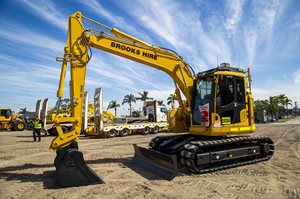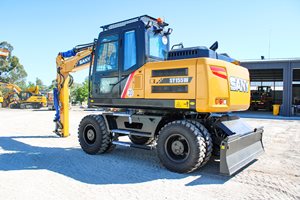Tracked vs Wheeled
With each offering an array of features, beneficial in their optimal conditions, choosing between a tracked and wheeled excavator can be a tough decision without first understanding your jobsite.
The working conditions and jobsite size, as well as your expected budget, are the predominant factors to be considered in this decision and can ultimately save you time and money, and effect the overall quality of work.

Seasonal Consistency
Determining your year-round jobsite conditions will be a main deciding factor in the selection. Because tracks and tyres are designed to perform best in certain terrains, consideration to changing weather throughout your job schedule, could be the difference between a successful operation and months of downtime.
With tracks spanning the length of the machine, tracked excavators are highly effective throughout seasonal fluctuations. Where wheels could become bogged in soft or wet ground conditions, the even weight distribution of tracks - and large surface area they cover - allow the excavator to seemingly ‘float’ over the surface without leaving too much indentation, where tyres would be churning the earth to gain traction. Weight distribution, measured in pound-force applied per square inch of the grounds surface (PSI), is higher under wheels, as the weight of the machine is distributed under 4 sharp points rather than along the large surface area of tracks. Having a lower PSI, is what allows tracked excavators to traverse more seamlessly in less than ideal wet and muddy weather conditions.
Jobsite Conditions & Machine Versatility
Wheeled excavators experience limitations in unrefined earth, where sharp rocks can penetrate their tyres. Alternatively, tracked machines excel in rocky conditions, and suffer in urbanised landscapes where tyres are most functional.
For tracked machines, the friction created by them on the surface of the ground, acts as a stabilising force for the machine and is a big factor to them being better suited to uneven worksites. Their heavy undercarriage, positioned closer to the ground, lowers their centre of gravity when compared to tyre traversing excavators, resulting in them being better suited to excavating areas of unstable earth.
Wheeled excavators, with a higher centre of gravity due to their smaller, elevated undercarriage, is more beneficial in instances where ground clearance is required, such as undulating terrain. They’re also preferable in urbanised landscapes, such as on concrete or asphalt, where their rubber wheels aren’t worn down as quickly as tracks. Not only do the tyres become less worn, but so too, does the site below; often, urban sites require finishing work, where the ground below is not damaged, of which a wheeled machine can achieve best.
Size of Your Job
In construction, mining and civil industries, time is costly, and the speed at which your machine can complete the job, is going to impact to your bottom line. Tracked machines are crawlers, reaching average speeds of 5-8kph. Wheeled machines, on the other hand, are hitting speeds of 30kph or more which can be a drastically beneficial asset to your project if there is significant ground to cover.
If, however, not much travelling is necessary and space is tighter, maneuverability may be more important. In which case, a tracked machine would be your best bet. Wheeled machines’ turning circles are much greater than the tracked machines’ turning system, which can turn in its own path by placing one track in reverse with the other in acceleration, granting you greater maneuverability on smaller worksites.

Budget
Where tracks are more susceptible to damage on concrete or asphalt surfaces, there’s a much larger possibility that wheeled machines will experience punctures if exposed to sharp surfaces. The longevity of the machine, and subsequent monetary savings, can be extended if you’re selecting the right one for your jobsite conditions.
The carriage design of tracked machines can make them far more expensive than wheeled excavators, due to the complex and substantial number of parts that require maintenance, not only when damaged, but in regular servicing. Initial costs are greater too, because of this.
Additionally, the overall lifespan of a tracked machine is shorter, however, consideration should be made to the fact that their potential for downtime is lesser, due to their versatility in yearly weather conditions, which can achieve major cost savings if your job will span into those wetter months.
The Verdict
Ultimately, if you know the terrain of your worksite, how far you need your machines to travel, and your budget, the deciding factors between a tracked or wheeled machine is reduced significantly. Additional features that can be changed or added to the machine, can also help with this decision.
Digging force, for example, is greater in tracked machines, due to the weight of the machine and built-in stabilisers, which make them a popular choice in construction and mining. Differing brands and machine size, will always provide a variety of designs to achieve the specifications for your job. Similarly, add-ons and swap-outs on machines, such as a range of tyre options, including ‘puncture proof’ tracked or foam tyre versions for wheeled machines and smaller undercarriage options for tracked machines, can provide substitutions needed to achieve results.
If you’re still unsure about which machine is best for you, or for more information on excavators, get in touch with the friendly Brooks Hire team on 1300 276 657.